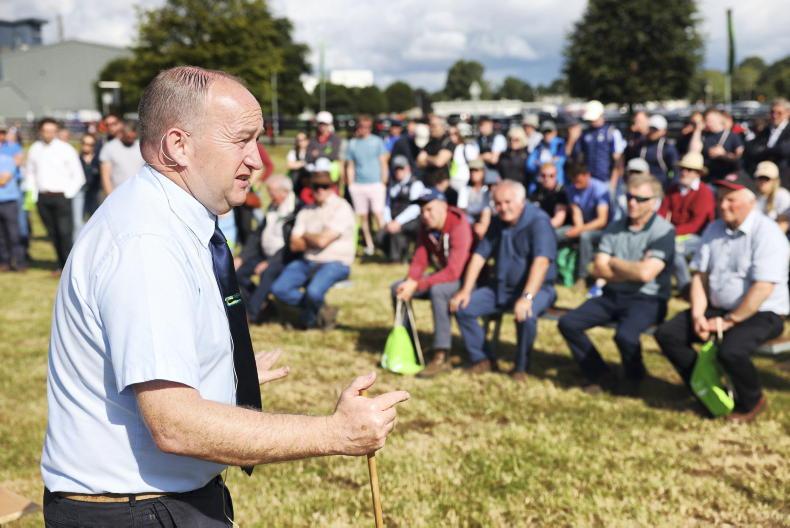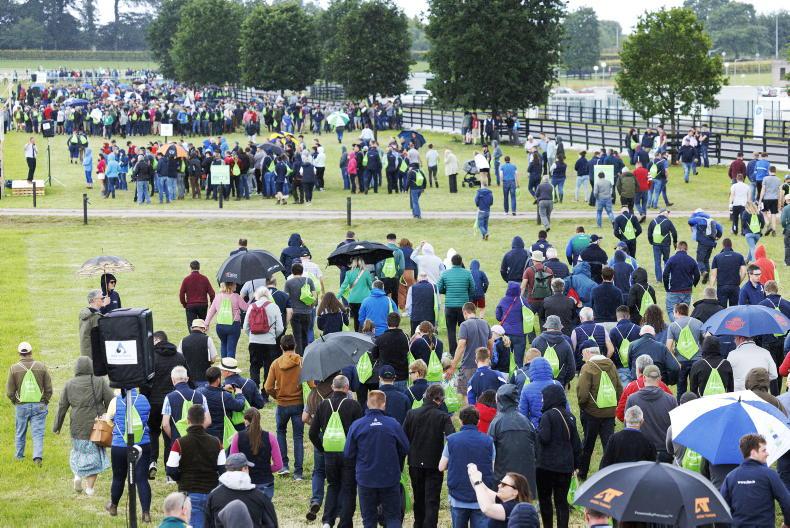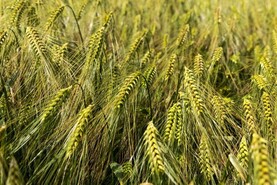The overriding sense from the Teagasc Moorepark Open Day was one of reflection on where the dairy sector has gone over the last 10 years of quota-free farming, and where it is going over the next 10 years.
Laurence Shalloo set the scene at the first board. On the environment, he said that all of the markers are going in the right direction; greenhouse gas emissions are 4.1% lower in 2023 compared to the base year of 2018 while ammonia emissions are 6% lower compared to 2005. Nitrate levels in rivers are falling and are the lowest since 2017.
On calves, he said that dairy farmer investment in sexed semen and improved beef artificial insemination (AI) means that the commercial beef value (CBV) of dairy calves is increasing by €5/year.
Reflecting back over the last three Moorepark open days, the emphasis was on the work that has to be done. The researchers were setting out their vision for how to overcome these environmental and calf challenges.
At Wednesday’s open day the message was clear: the environmental and calf welfare measures farmers have taken on board are working.
Good with the bad
That first board wasn’t all good news. Laurence showed that costs of production have increased by 50% since 2020. He said that in the first five years of quotas going, costs barely rose at all, but in the last five years they have spiralled. He warned the thousands of farmers that stood in Moorepark over the course of the day that input cost inflation is not the only answer as to why this has happened.
He says cost control has been a casualty of the higher milk prices.
Acknowledging poor grass growth rates as being a contributory factor, he said that the amount of grass being utilised on dairy farms is decreasing. It was 8.3t DM/ha in 2022, 8.1t DM/ha in 2023 and down to 8t DM/ha in 2024.
As a result, he highlighted how the proportion of home-grown feeds (grazed grass and homemade silage) in the diet of dairy cows has decreased from the peak of 82% in 2015 to the startling figure of just 76% in 2024.
This just shows the increased reliance on purchased feed, both concentrates and silage, now versus 10 years ago.
Laurence highlighted the vulnerable position this puts dairy farmers in; with more exposure to the feed market and input cost inflation. Reducing the proportion of purchased feed was a common theme throughout the day.
The first board also highlighted two other issues: that the number of replacement heifers available has crashed from 26% in 2015 to just under 20% in 2025 – a statistic that Laurence described as unsustainable.
Looking to the future, Laurence said that farmers must re-focus their efforts on growing more grass and reducing the costs of production. On succession, he said that the age profile of dairy farmers is increasing with less than 5% under 35 years of age.
He said that farmers should invest in and adapt workplaces to make farming a more desirable career option for young people.
Business of farming
On the business of farming board, Brendan Horan encouraged farmers to show more innovation, saying that businesses that don’t innovate end up declining. He was referring to the fact that if Irish dairy farmers innovate to improve productivity, reduce costs and simplify practices they will be in a great position to see off any future challenges.
On costs and income, Brendan highlighted the huge volatility over the last few years and how exposed Irish farmers are becoming to input costs, with concentrate feed costs now accounting for 25% of all costs – the most stark figure throughout the entire day.
Brendan said the impact of the higher cost structure was most notable in 2023 when family farm income per person more than halved from the 2022 level. This was due, he said, to a drop in milk price, but also due to increased costs as the full impact of feed and fertiliser price inflation became apparent.
On the key performance indicators highlighted in Table 1, Brendan said these are a mixed bag, with good progress in some areas, such as six-week calving rate and labour efficiency but poor progress in other areas such as improving soil fertility with still only 24% of soils on dairy farms at optimum soil fertility.
Meal feeding rates have increased at the same time as the percentage of grazed grass in the diet has decreased.
On making dairy farms more attractive places to work, Brendan said there is more that farmers can do in this area. He said that based on labour studies, the average number of hours worked per week from 1 February to 1 July is 61 hours per week, with the top 25% working 51 hours per week while the target is 48 hours per week.
The average number of days off per year is just 19 days, while the top 25% take 33 days off, but he said that this is still well below the industry target of 60 days off per year.
The point being made was that the old attitude of working long and hard is not just a perception, it’s also a practice. He said that this practice is visible to young people – they see it in their own family and they see it among their neighbours, and so young people are making the decision that dairying isn’t the career for them.
Unless farmers change practices and become positive role models for a career as a dairy farmer then the situation won’t change, he warned.

Brendan Horan speaking at Moorepark 2025 as thousands of dairy farmers from across Ireland attended the Moorepark open day on Wednesday where the theme of the day was ‘innovating for the future’. See more pages 32 and 33
Investments
With 2025 shaping up to be a good year financially, Brendan said that farmers need to be sensible with how money is spent. He said that investments in improving grazing infrastructure will give rapid returns, such as reseeding, improving soil fertility, roadways and improving water infrastructure.
The next category of sensible investment is in facilities such as increasing slurry storage, improving milking facilities, animal housing and animal handling. He said the third category of investment in technology and automation should only be considered when the first two requirements are met.
He referred to technologies such as robots, automatic calf feeders and automated heat and health detection aids as proven, but that they come at a cost.
Summarising, Brendan said that in order to innovate, dairy farmers need to refocus on the basics of what makes a good dairy farm, invest profits sensibly and focus on making dairy farms more attractive places to work.

Laurence Shalloo presents to attendees as thousands of dairy farmers from across Ireland attended the Moorepark open day on Wednesday where the theme of the day was ‘innovating for the future’. See more pages 32 and 33
Grassland
Meanwhile at the grassland board, Michael O’Donovan highlighted the slip in grass growth and grass utilisation over the last few years. The differences in performances are stark, with the top farms on PastureBase growing and utilising 2t DM/ha more than the average with not too dissimilar uses of chemical nitrogen (N).
Michael said the top farms are spreading 200kg N/ha while the average farms are spreading 190kg N/ha, but the top farms are driving performance with clover, have better soil fertility, are reseeding 15% to 30% of the farm per year and are feeding 300kg/cow less meal at 800kg/cow versus 1,100kg/cow for the average farm.
He said the key steps to increasing growth rates are to immediately improve soil fertility, with an extra 1.5t DM/ha of grass available if soil pH is corrected to 6.5.
He said targeting eight grazing rotations per year will increase grass growth saying farmers are not achieving these grazings because they are letting covers get too big and on too long a rotation length for much of the year.
He also said that grazing management can be improved on lots of farms, particularly around managing autumn closing covers to ensure there is enough grass on the farm in spring to let cows out early and reduce supplement use.
Finally, he said targeting high pasture profit index ryegrass and proven high performing clover varieties can add an extra 1.5t to 2.5t DM/ha of pasture growth.
In short
Thousands of farmers flocked through the gates of Teagasc Moorepark on Wednesday to attend the Moorepark open day, held every two years. The Teagasc scientists highlighted that progress is being made on key environmental challenges but that technical farming challenges remain. There has been a 50% increase in costs since 2020 and the event highlighted ways for farmers to reduce their costs. Farmers were encouraged to prioritise investments in areas with a high return such as reseeding and soil fertility before looking at increasing automation.
The overriding sense from the Teagasc Moorepark Open Day was one of reflection on where the dairy sector has gone over the last 10 years of quota-free farming, and where it is going over the next 10 years.
Laurence Shalloo set the scene at the first board. On the environment, he said that all of the markers are going in the right direction; greenhouse gas emissions are 4.1% lower in 2023 compared to the base year of 2018 while ammonia emissions are 6% lower compared to 2005. Nitrate levels in rivers are falling and are the lowest since 2017.
On calves, he said that dairy farmer investment in sexed semen and improved beef artificial insemination (AI) means that the commercial beef value (CBV) of dairy calves is increasing by €5/year.
Reflecting back over the last three Moorepark open days, the emphasis was on the work that has to be done. The researchers were setting out their vision for how to overcome these environmental and calf challenges.
At Wednesday’s open day the message was clear: the environmental and calf welfare measures farmers have taken on board are working.
Good with the bad
That first board wasn’t all good news. Laurence showed that costs of production have increased by 50% since 2020. He said that in the first five years of quotas going, costs barely rose at all, but in the last five years they have spiralled. He warned the thousands of farmers that stood in Moorepark over the course of the day that input cost inflation is not the only answer as to why this has happened.
He says cost control has been a casualty of the higher milk prices.
Acknowledging poor grass growth rates as being a contributory factor, he said that the amount of grass being utilised on dairy farms is decreasing. It was 8.3t DM/ha in 2022, 8.1t DM/ha in 2023 and down to 8t DM/ha in 2024.
As a result, he highlighted how the proportion of home-grown feeds (grazed grass and homemade silage) in the diet of dairy cows has decreased from the peak of 82% in 2015 to the startling figure of just 76% in 2024.
This just shows the increased reliance on purchased feed, both concentrates and silage, now versus 10 years ago.
Laurence highlighted the vulnerable position this puts dairy farmers in; with more exposure to the feed market and input cost inflation. Reducing the proportion of purchased feed was a common theme throughout the day.
The first board also highlighted two other issues: that the number of replacement heifers available has crashed from 26% in 2015 to just under 20% in 2025 – a statistic that Laurence described as unsustainable.
Looking to the future, Laurence said that farmers must re-focus their efforts on growing more grass and reducing the costs of production. On succession, he said that the age profile of dairy farmers is increasing with less than 5% under 35 years of age.
He said that farmers should invest in and adapt workplaces to make farming a more desirable career option for young people.
Business of farming
On the business of farming board, Brendan Horan encouraged farmers to show more innovation, saying that businesses that don’t innovate end up declining. He was referring to the fact that if Irish dairy farmers innovate to improve productivity, reduce costs and simplify practices they will be in a great position to see off any future challenges.
On costs and income, Brendan highlighted the huge volatility over the last few years and how exposed Irish farmers are becoming to input costs, with concentrate feed costs now accounting for 25% of all costs – the most stark figure throughout the entire day.
Brendan said the impact of the higher cost structure was most notable in 2023 when family farm income per person more than halved from the 2022 level. This was due, he said, to a drop in milk price, but also due to increased costs as the full impact of feed and fertiliser price inflation became apparent.
On the key performance indicators highlighted in Table 1, Brendan said these are a mixed bag, with good progress in some areas, such as six-week calving rate and labour efficiency but poor progress in other areas such as improving soil fertility with still only 24% of soils on dairy farms at optimum soil fertility.
Meal feeding rates have increased at the same time as the percentage of grazed grass in the diet has decreased.
On making dairy farms more attractive places to work, Brendan said there is more that farmers can do in this area. He said that based on labour studies, the average number of hours worked per week from 1 February to 1 July is 61 hours per week, with the top 25% working 51 hours per week while the target is 48 hours per week.
The average number of days off per year is just 19 days, while the top 25% take 33 days off, but he said that this is still well below the industry target of 60 days off per year.
The point being made was that the old attitude of working long and hard is not just a perception, it’s also a practice. He said that this practice is visible to young people – they see it in their own family and they see it among their neighbours, and so young people are making the decision that dairying isn’t the career for them.
Unless farmers change practices and become positive role models for a career as a dairy farmer then the situation won’t change, he warned.

Brendan Horan speaking at Moorepark 2025 as thousands of dairy farmers from across Ireland attended the Moorepark open day on Wednesday where the theme of the day was ‘innovating for the future’. See more pages 32 and 33
Investments
With 2025 shaping up to be a good year financially, Brendan said that farmers need to be sensible with how money is spent. He said that investments in improving grazing infrastructure will give rapid returns, such as reseeding, improving soil fertility, roadways and improving water infrastructure.
The next category of sensible investment is in facilities such as increasing slurry storage, improving milking facilities, animal housing and animal handling. He said the third category of investment in technology and automation should only be considered when the first two requirements are met.
He referred to technologies such as robots, automatic calf feeders and automated heat and health detection aids as proven, but that they come at a cost.
Summarising, Brendan said that in order to innovate, dairy farmers need to refocus on the basics of what makes a good dairy farm, invest profits sensibly and focus on making dairy farms more attractive places to work.

Laurence Shalloo presents to attendees as thousands of dairy farmers from across Ireland attended the Moorepark open day on Wednesday where the theme of the day was ‘innovating for the future’. See more pages 32 and 33
Grassland
Meanwhile at the grassland board, Michael O’Donovan highlighted the slip in grass growth and grass utilisation over the last few years. The differences in performances are stark, with the top farms on PastureBase growing and utilising 2t DM/ha more than the average with not too dissimilar uses of chemical nitrogen (N).
Michael said the top farms are spreading 200kg N/ha while the average farms are spreading 190kg N/ha, but the top farms are driving performance with clover, have better soil fertility, are reseeding 15% to 30% of the farm per year and are feeding 300kg/cow less meal at 800kg/cow versus 1,100kg/cow for the average farm.
He said the key steps to increasing growth rates are to immediately improve soil fertility, with an extra 1.5t DM/ha of grass available if soil pH is corrected to 6.5.
He said targeting eight grazing rotations per year will increase grass growth saying farmers are not achieving these grazings because they are letting covers get too big and on too long a rotation length for much of the year.
He also said that grazing management can be improved on lots of farms, particularly around managing autumn closing covers to ensure there is enough grass on the farm in spring to let cows out early and reduce supplement use.
Finally, he said targeting high pasture profit index ryegrass and proven high performing clover varieties can add an extra 1.5t to 2.5t DM/ha of pasture growth.
In short
Thousands of farmers flocked through the gates of Teagasc Moorepark on Wednesday to attend the Moorepark open day, held every two years. The Teagasc scientists highlighted that progress is being made on key environmental challenges but that technical farming challenges remain. There has been a 50% increase in costs since 2020 and the event highlighted ways for farmers to reduce their costs. Farmers were encouraged to prioritise investments in areas with a high return such as reseeding and soil fertility before looking at increasing automation. 







 This is a subscriber-only article
This is a subscriber-only article










SHARING OPTIONS: